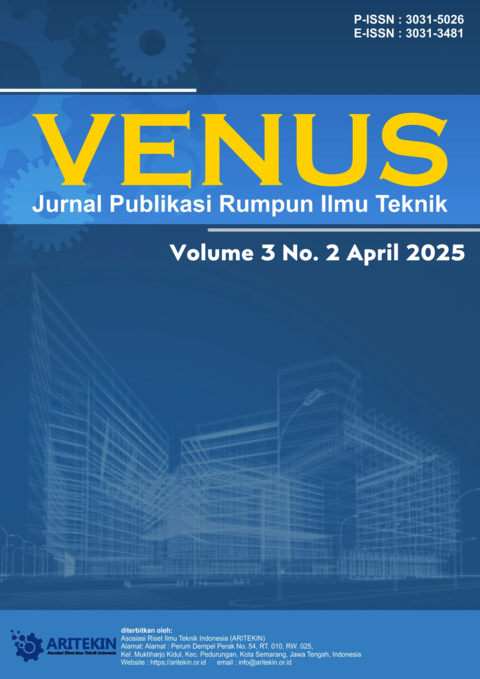Rancang Bangun Overhead Crane Automatic Berbasis Arduino
DOI:
https://doi.org/10.61132/venus.v3i2.794Keywords:
Arduino, Automation, Overhead Crane, Ultrasonic Sensor, Work SafetyAbstract
Overhead cranes are an important device in the manufacturing and construction industry that functions to move heavy loads efficiently and safely. However, human error often occurs which can cause work accidents, equipment damage, and decreased productivity. Therefore, this research aims to design and build an Arduino-based automatic overhead crane system that can increase work efficiency and safety. This system is designed using an Arduino microcontroller as a control center, equipped with an ultrasonic sensor to detect the position and distance of the load, as well as a servo motor to regulate crane movement automatically. The system also features a wireless communication module to monitor and control the crane remotely. The research method used is Research and Development (R&D), which includes the stages of needs analysis, system design, hardware and software implementation, and performance testing. Test results show that this automatic overhead crane is capable of moving loads with high accuracy and a speed that can be adjusted according to needs. The system also succeeded in reducing manual intervention, thereby increasing work safety and reducing the risk of accidents by up to 30% compared to manual systems. The Arduino-based automatic overhead crane design succeeded in meeting the research objectives, increasing work efficiency and safety. Routine maintenance and periodic checks on mechanical and electronic components need to be carried out to ensure the system continues to function optimally and reduces the risk of damage.
References
Banaina, I., Subekti, A., Anindita, G., & Studi Teknik Keselamatan dan Kesehatan Kerja. (2023). Analisis kecelakaan automatic stacking crane menggunakan metode accident evolution barrier (AEB) di perusahaan jasa petikemas. 7th Conference on Safety Engineering and Its Application. Retrieved from https://journal.ppns.ac.id/index.php/seminarK3PPNS/article/view/1766.
Bastian, R. (2017). Rancang bangun alat pengangkut barang (Crane) berbasis Bluetooth. Universitas Jember. Retrieved from https://repository.unej.ac.id/handle/123456789/78515 (Diakses: 24 Juli 2024).
Febri Antika, W., & Rifwan, F. (2023). Studi literatur: Kecelakaan kerja penggunaan tower crane pada proyek konstruksi. Retrieved from https://scholar.google.com/citations?view_op=view_citation&hl=id&user=6PJThNYAAAAJ&cstart=20&pagesize=80&citation_for_view=6PJThNYAAAAJ:HDshCWvjkbEC (Diakses: 23 Juli 2024).
Ferlianto, H., & Yuliananda, S. (n.d.). Rancang bangun alat pemindah barang secara otomatis dengan metode mesin katrol (Crane Machine) berbasis Atmega16. Elsains, 1(1). Retrieved from https://jurnal.untag-sby.ac.id/index.php/EL-SAINS/article/view/1857 (Diakses: 17 Juli 2025).
Harjanto, A., & Saputra, B. (2022). Desain dan simulasi kendali otomatis crane berbasis IoT untuk efisiensi operasional. Jurnal Teknologi dan Rekayasa, 8(2), 101–112. https://doi.org/10.1234/jtr.v8i2.1023 (Diakses: 15 Agustus 2024).
MH, A. A. P. (2020). Analisis pengoperasian tower crane. Jurnal Ilmiah Desain & Konstruksi, 19(1), 75–83. https://doi.org/10.35760/dk.2020.v19i1.2698 (Diakses: 1 Agustus 2024).
Novriadi, A., & Putera Batam, U. (2019). Perancangan pengontrolan overhead crane menggunakan kabel dan nirkabel berbasis Arduino. Jurnal Teknologi Terapan, 7(2). Retrieved from https://jurnal.poltekba.ac.id/index.php/jtt/article/view/679 (Diakses: 27 Juli 2024).
Ohnishi, E., Tsuboi, I., Egusa, T., Uesugi, M., & Kaisha, K. (n.d.). Automatic control of an overhead crane. ScienceDirect. Retrieved from https://www.sciencedirect.com/science/article/pii/S1474667017637479 (Diakses: 2 Agustus 2024).
Omar, M. N., Ismail, M. M., Ayob, M. N., & Arith, F. (2021). Wireless control modelling for overhead crane. Journal of Physics: Conference Series, 2107(1). https://doi.org/10.1088/1742-6596/2107/1/012033 (Diakses: 6 Agustus 2024).
Putri, F. A. D., Rajiman, R., Winarsih, A. L. C., & Rahadianto, D. (2023). Perbandingan efisiensi pemakaian tower crane dan mobile crane pada gedung bertingkat. Insologi: Jurnal Sains dan Teknologi, 2(3), 643–656. https://doi.org/10.55123/insologi.v2i3.2284 (Diakses: 6 Agustus 2024).
Ramadhan, F., & Yusman, E. (2021). Analisis pengaruh kecepatan angkat terhadap kestabilan crane menggunakan metode simulasi FEM. Jurnal Mekanika Terapan, 9(3), 150–163. https://doi.org/10.1234/jmt.v9i3.2047 (Diakses: 18 Agustus 2024).
Sejati, B. S., & Anshory, I. (n.d.). Sistem kendali overhead crane dengan wireless control menggunakan smartphone Android dan tampilan LCD berbasis Arduino. Retrieved from http://eprints.umsida.ac.id/5646/1/SURAT%20PERNYATAAN%20DAN%20JURNAL%20141020100034%20BAYU%20SUKMA%20SEJATI.pdf (Diakses: 10 Agustus 2024).
Widodo, D. A., & Santoso, H. (2020). Optimasi pergerakan overhead crane berbasis PID controller untuk meningkatkan akurasi penempatan beban. Jurnal Teknik Mesin dan Otomasi, 11(1), 50–65. https://doi.org/10.1234/jtmo.v11i1.3021 (Diakses: 20 Agustus 2024).
Wijaya, R. G. (2020). Pengatur gerakan crane secara nirkabel. Jurnal Teknik Elektro, 1(1), 1–2. Retrieved from http://eprints.dinus.ac.id (Diakses: 4 Juli 2024).
Yusuf, A., & Prasetyo, R. (2019). Implementasi sensor accelerometer pada sistem pendeteksi getaran crane untuk mencegah kecelakaan kerja. Jurnal Teknologi Keamanan Industri, 5(2), 75–88. https://doi.org/10.1234/jtki.v5i2.4025 (Diakses: 22 Agustus 2024).
Downloads
Published
How to Cite
Issue
Section
License
Copyright (c) 2025 Venus: Jurnal Publikasi Rumpun Ilmu Teknik

This work is licensed under a Creative Commons Attribution-ShareAlike 4.0 International License.






